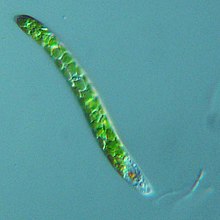Euglenaceae: Difference between revisions
m →Phylogeny: pro parte |
→Phylogeny: added alternate phylogeny |
||
| Line 24: | Line 24: | ||
== Phylogeny == |
== Phylogeny == |
||
In its current [[circumscription (taxonomy)|circumscription]], Euglenaceae is [[monophyletic]].<ref name=Kim>{{cite journal | doi=10.1111/j.1529-8817.2010.00910.x | title=Multigene Analyses of Photosynthetic Euglenoids and New Family, Phacaceae (Euglenales)1 | year=2010 | last1=Kim | first1=Jong Im | last2=Shin | first2=Woongghi | last3=Triemer | first3=Richard E. | journal=Journal of Phycology | volume=46 | issue=6 | pages=1278–1287 | s2cid=86347770 }}</ref> Its sister family is [[Phacaceae]], which contains several genera (''[[Lepocinclis]]'', ''[[Phacus]]'', and ''[[Discoplastis]]'') formerly included within Euglenaceae.<ref name=Kim/> |
In its current [[circumscription (taxonomy)|circumscription]], Euglenaceae is [[monophyletic]].<ref name=Kim>{{cite journal | doi=10.1111/j.1529-8817.2010.00910.x | title=Multigene Analyses of Photosynthetic Euglenoids and New Family, Phacaceae (Euglenales)1 | year=2010 | last1=Kim | first1=Jong Im | last2=Shin | first2=Woongghi | last3=Triemer | first3=Richard E. | journal=Journal of Phycology | volume=46 | issue=6 | pages=1278–1287 | s2cid=86347770 }}</ref> Its sister family is [[Phacaceae]], which contains several genera (''[[Lepocinclis]]'', ''[[Phacus]]'', and ''[[Discoplastis]]'') formerly included within Euglenaceae.<ref name=Kim/> Two phylogenies are shown below. |
||
===Kim et al. (2010)=== |
|||
In this phylogeny, most ''Euglena'' species are sister to a clade consisting of ''Euglenaria'' and ''Euglena archaeoplastidiata''.<ref name=Kim/> |
|||
{{Clade|label1=[[Euglenales]]|1= |
{{Clade|label1=[[Euglenales]]|1= |
||
{{Clade |
{{Clade |
||
| Line 52: | Line 54: | ||
|1=''[[Colacium]]'' |
|1=''[[Colacium]]'' |
||
|2=''[[Euglena velata]]'' |
|2=''[[Euglena velata]]'' |
||
}} |
|||
}} |
|||
}} |
|||
|2=''[[Euglenaformis]]'' |
|||
}} |
|||
|2=[[Phacaceae]] (outgroup) |
|||
}} |
|||
}} |
|||
===Bicudo & Menezes (2016)=== |
|||
This phylogeny places ''Euglena'' as sister to all other genera in Euglenaceae except for the genus ''Euglenaformis''.<ref>{{cite journal | doi=10.3389/fevo.2016.00017 | doi-access=free | title=Phylogeny and Classification of Euglenophyceae: A Brief Review | year=2016 | last1=Bicudo | first1=Carlos E. de M. | last2=Menezes | first2=Mariângela | journal=Frontiers in Ecology and Evolution | volume=4 }}</ref> |
|||
{{Clade|label1=[[Euglenales]] |
|||
|1={{clade|label1=Euglenaceae |
|||
|1={{clade |
|||
|1={{clade |
|||
|1=''[[Euglena]] pro parte'' |
|||
|2={{clade |
|||
|1={{clade |
|||
|1={{clade |
|||
|1={{clade |
|||
|1=''[[Cryptoglena]]'' |
|||
|2=''[[Monomorphina]]'' |
|||
}} |
|||
|2=''[[Euglenaria]]'' |
|||
}} |
|||
|2=''[[Euglena archaeoplastidiata]]'' |
|||
}} |
|||
|2={{clade |
|||
|1={{clade |
|||
|1=''[[Strombomonas]]'' |
|||
|2=''[[Trachelomonas]]'' |
|||
}} |
|||
|2=''[[Colacium]]'' |
|||
}} |
}} |
||
}} |
}} |
||
Revision as of 21:18, 3 May 2023
| Euglenaceae | |
|---|---|

| |
| Euglena mutabilis | |
| Scientific classification | |
| Domain: | Eukaryota |
| Phylum: | Euglenozoa |
| Class: | Euglenida |
| Clade: | Euglenophyceae |
| Order: | Euglenales |
| Family: | Euglenaceae Dujardin, 1841 |
| Genera | |
Euglenaceae (also known as Euglenidae) is a family of flagellates in the phylum Euglenozoa. The family includes the most well-known euglenoid genus, Euglena.[1]
Morphology
Euglenaceae show the most morphological diversity within the class Euglenophyceae.[2] They are mostly single-celled organisms, except for the genus Colacium. They are free-living or sometimes inhabiting the digestive tracts of animals.[1] Two genera, Strombomonas and Trachelomonas produce outer shells called loricae.[3]
As with other euglenids, cells in the Euglenaceae are surrounded by a series of proteinaceous strips called the pellicle; the pellicle can stretch in most genera, allowing the cell to contract, creating a type of movement called metaboly. The genus Monomorphina is rigid or slightly metabolic.[1] Chloroplasts are present in most species, except for a few species that have lost them.[1] Chloroplasts are diverse in this family, with the size, number, and presence of pyrenoids being important identifying characteristics.[1]
Phylogeny
In its current circumscription, Euglenaceae is monophyletic.[3] Its sister family is Phacaceae, which contains several genera (Lepocinclis, Phacus, and Discoplastis) formerly included within Euglenaceae.[3] Two phylogenies are shown below.
Kim et al. (2010)
In this phylogeny, most Euglena species are sister to a clade consisting of Euglenaria and Euglena archaeoplastidiata.[3]
| Euglenales |
| ||||||
Bicudo & Menezes (2016)
This phylogeny places Euglena as sister to all other genera in Euglenaceae except for the genus Euglenaformis.[4]
| Euglenales |
| ||||||
References
- ^ a b c d e f Kostygov AY, Karnkowska A, Votýpka J, Tashyreva D, Maciszewski K, Yurchenko V, Lukeš J (March 2021). "Euglenozoa: taxonomy, diversity and ecology, symbioses and viruses". Open Biology. 11 (3): 200407. doi:10.1098/rsob.200407. PMC 8061765. PMID 33715388.
- ^ Bennett, Matthew S.; Triemer, Richard E. (2015). "Chloroplast Genome Evolution in the Euglenaceae". Journal of Eukaryotic Microbiology. 62 (6): 773–785. doi:10.1111/jeu.12235. PMID 25976746. S2CID 6208110.
- ^ a b c d Kim, Jong Im; Shin, Woongghi; Triemer, Richard E. (2010). "Multigene Analyses of Photosynthetic Euglenoids and New Family, Phacaceae (Euglenales)1". Journal of Phycology. 46 (6): 1278–1287. doi:10.1111/j.1529-8817.2010.00910.x. S2CID 86347770.
- ^ Bicudo, Carlos E. de M.; Menezes, Mariângela (2016). "Phylogeny and Classification of Euglenophyceae: A Brief Review". Frontiers in Ecology and Evolution. 4. doi:10.3389/fevo.2016.00017.
